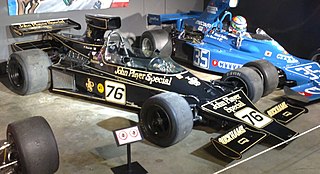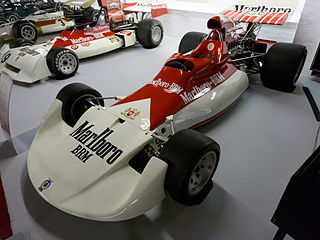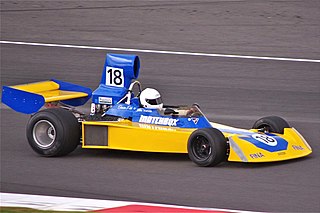
The 1976 Austrian Grand Prix was a Formula One motor race held at the Österreichring on 15 August 1976. It was the eleventh race of the 1976 World Championship of F1 Drivers and the 1976 International Cup for F1 Constructors.

Jean-Pierre Maurice Georges Beltoise was a French Grand Prix motorcycle road racer and Formula One driver who raced for the Matra and BRM teams. He competed in 88 Grands Prix achieving a single victory, at the 1972 Monaco Grand Prix, and a total of eight podium finishes.

Ian Macpherson McCallum Stewart was a British racing driver from Scotland.

Peter Nield Whitehead was a British racing driver. He was born in Menston, Yorkshire and was killed in an accident at Lasalle, France, during the Tour de France endurance race. A cultured, knowledgeable and well-travelled racer, he was excellent in sports cars. He won the 1938 Australian Grand Prix, which along with a 24 Heures du Mans win in 1951, probably was his finest achievement, but he also won two 12 Heures internationales de Reims events. He was a regular entrant, mostly for Peter Walker and Graham Whitehead, his half-brother. His death in 1958 ended a career that started in 1935 – however, he was lucky to survive an air crash in 1948.

Chris Amon Racing, also known simply as Amon, was a Formula One team established by New Zealand driver Chris Amon. It competed as a privateer team in the 1966 Italian Grand Prix, then as a constructor in its own right in the 1974 Formula One season.

Team Penske is an American professional auto racing organization, competing in the IndyCar Series, NASCAR Cup Series, IMSA SportsCar Championship and FIA World Endurance Championship. Debuting at the 1966 24 Hours of Daytona, the organization has also competed in various other types of professional racing such as Formula One, Can-Am, Trans Am, FIA World Endurance Championship and Australian Supercars. Altogether, Team Penske has earned over 500 victories and over 40 championships in all of auto racing. Team Penske is a division of Penske Corporation, and is owned and chaired by Roger Penske. The team president is Tim Cindric.

The Lotus 76 is a Formula One car designed by Colin Chapman, Tony Rudd and Ralph Bellamy and used by Team Lotus in the 1974 Formula One season.

The BRM P180 was a Formula One racing car, built by BRM and designed by Tony Southgate which raced in the 1972 Formula One season. It was powered by a BRM 3.0-litre V12 engine. One of the main features of the P180 was that the radiators had moved to the rear of the car, allowing the nose of the car to be very wide and flat. It competed in five World Championship Grands Prix, with a total of seven individual entries. The car scored no World Championship points, its best finish being eighth at the 1972 Italian Grand Prix.

The BRM P138 was a Formula One racing car designed by Len Terry which raced in the 1968 and 1969 Formula One seasons. It was powered by a 3.0-litre V12 engine.

The Hesketh 308C was a Formula One racing car designed by Harvey Postlethwaite and used by Hesketh Racing in the latter stages of the 1975 Formula One season. The car featured the rubber suspension which Postlethwaite had pioneered on the preceding 308B model and a Ford-Cosworth DFV engine. In 1976, the car was acquired by Wolf–Williams Racing and rebranded as the Wolf–Williams FW05.

The Lola T370 was a Formula One car designed by Andy Smallman and used by Embassy Hill in the 1974 season and the early part of the 1975 season. After an unsuccessful 1973 with a customer Shadow DN1, the Embassy Hill team commissioned its own cars from Lola. The T370 was largely based on Formula 5000 designs, and looked similar to Lola's F5000 cars, although it sported an extremely large airbox. Embassy Hill had two cars for Graham Hill and Guy Edwards. The car was tested well before the end of 1973 in readiness for the January start to the 1974 season.

The Tyrrell 001 is a Formula One racing car which was designed by Tyrrell Racing's chief designer, Derek Gardner and used at the end of the 1970 and the beginning of the 1971 Formula One season. The car competed in five Grands Prix, retiring on four occasions and achieving one second-place finish.

The Surtees TS7 was a Formula One car used by Surtees during the 1970 and 1971 Formula One seasons. It was designed by John Surtees, Shahab Ahmed and Peter Connew.

The Williams FW was a Formula One car used by Frank Williams Racing Cars during the 1973, 1974 and 1975 seasons. It was designed by John Clarke.

The Fittipaldi FD was a series of Formula One chassis designed by Richard Divila and used by Fittipaldi Automotive in the 1975, 1976 and 1977 seasons. The initial chassis was designated Fittipaldi FD01 and there were three minor developments designated, Fittipaldi FD02, Fittipaldi FD03 and Fittipaldi FD04 respectively. FD series cars competed in 37 races making 43 individual entries in total. The chassis achieved a best finish of fourth place at both the 1977 Argentine and Brazilian Grands Prix driven on each occasion by former World Champion and joint team-owner Emerson Fittipaldi. It scored a total of 11 World Championship points.

The Surtees TS16 was a Formula One car used by Surtees during the 1974, 1975 and 1976 Formula One seasons. It was designed by John Surtees.
The Parnelli VPJ4 was a Formula One racing car designed by Maurice Philippe, and used by Vel's Parnelli Jones Racing during the 1974, 1975 and 1976 Formula One seasons.

The Penske PC3 was a Formula One car used by Citibank Team Penske during the 1976 Formula One season, It was designed by Geoff Ferris.

The Tyrrell 007 is a Formula One racing car, designed by Tyrrell's Chief Designer, Derek Gardner. It was used in the 1974, 1975, 1976 and 1977 Formula One seasons.

The ATS HS1 was a Formula One car used by ATS during the 1978 Formula One season. It was designed by John Gentry and Robin Herd.



















